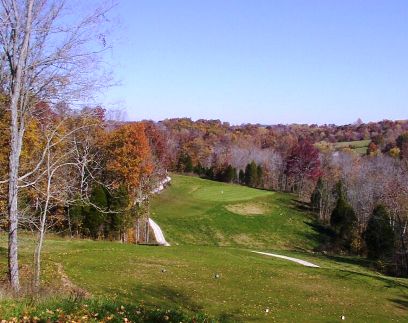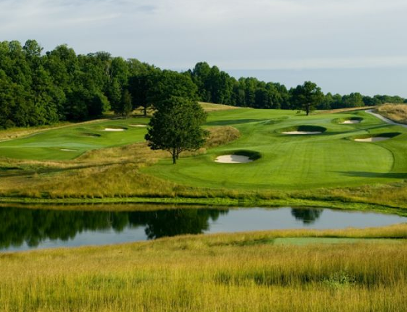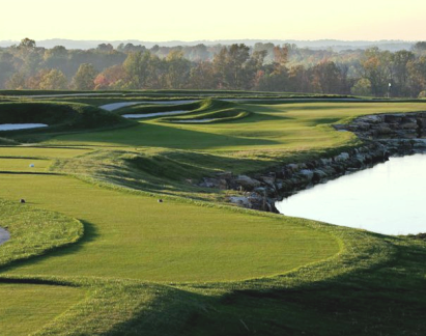Detailed description of Old English Golf Course
Old English Golf Course is a Public, 18 hole golf course located in English, Indiana.
Old English Golf Course first opened for play in 2002. The course was designed by Dr. Michael Hurdzan.
There's a big and interesting story behind this course, Kathy McKimmie tells it very well..
------------------------------------------
By McKimmie, Kathy Indiana Business Magazine, Date: April 2003
Move the town to higher ground. That's what the residents of English--population under 1,000--decided with federal help after periodic flooding from swelling creeks and the Little Blue River had ravaged their homes and businesses for generations. But what would become of their old town?
Cary Hammond offered his vision in a business plan drafted as part of a course at Indiana University's Kelley School of Business in 1988; he would transform the bones of his hometown into a golf course.
Fourteen years later, after buildings were demolished and the services of a world-renowned golf-course architect were arranged, an 18-hole championship course opened in 2002 on 300 acres. Old English Golf Course is now the pride of the town and the fulfillment of a college kid's dream.
English clerk-treasurer Wayne Carothers credits a lot of people for seeing the voluntary relocation project through, but he gives kudos to former U.S. Rep. Lee Hamilton and U.S. Sen. Richard Lugar for guiding local officials through the maze of federal programs. "Hamilton, Lugar, and the regional planning agency kept our chins up, so to speak."
Carothers estimates that more than $6 million in state and federal funds were spent acquiring more than 100 parcels of property, demolishing old buildings, performing environmental cleanup, preparing infrastructure and handling other move-related tasks. In the long run, though, millions will be saved by not having to rebuild the town after each flood. The move was completed in 1999.
"It took eight years to move the houses out of the way," says Hammond, so if his project had been just a golf course locals would probably have said "the heck with it" long ago. "We wanted to see something happen here in our hometown. To be the project that gives hope to your hometown is the thrill." He was able to squeeze in five years in marketing and sales at WTPI-FM in Indianapolis and another five in marketing at Hoosier Energy before assuming the general manager's job in 2000 when course construction began.
On the site of the former town sit three holes of the new golf course, says Carothers. "We lease it at fair value of what it would cost for leased farmland." Some might think it's strange to lease public land for a privately owned golf course, he says, but the town gets green space and actually saves money by not having to maintain the property.
Old English Golf Course LLC was formed in 1996 to begin work on the course. Hammond and friend Mark Megenity, a local fourth-grade teacher, began raising money. "We went to friends and neighbors and would sit in their kitchen and tell them the story. We needed money to do it. We needed to buy land for an 18-hole course."
The initial goal was to raise $800,000, all from small local investments (no more than $15,000 per person), and they attracted the 150 investors they needed to get it done. "In contrast, most golf courses today may have guys that plop down $1-2-3 million apiece," says Hammond, who serves as president as well as general manager. But what kind of course can you build on a shoestring?
ENTER DR. HURDZAN
"I heard the story of English," says golf-course designer Dr. Michael Hurdzan, "These guys had no money and were trying to put together a golf course. They were trying to save their town." He decided to give back to the sport he loves by donating the design services of his Columbus, Ohio, firm, Hurdzan-Fry. "Anyone who earns a living from the game of golf has an obligation to make it grow."
"When Hurdzan came on board and donated services he started a movement," says Hammond. "Other suppliers and vendors called. Bulldozers, earthmoving equipment, further donations and discounts--$1 million of donations came in and it all started with Dr. Hurdzan. We now have a $4 million to $5 million golf course and our investment is in the $2 1/2 million to $3 million range."
Hurdzan, a 23-year Green Beret commander who specialized in survival techniques and guerrilla warfare, has been a golf-course designer for more than three decades, with a master's in landscape architecture and a Ph.D. in environmental plant physiology. Among his honors are the 2002 Donald A. Ross Award from the Golf Course Builders Association of America and Golf World Mag azine's 1997 Architect of the Year Award. Working with partner Dana Fry, Hurdzan has created numerous courses on "best of' lists, including Naples National Golf Club in Florida and Devil's Paintbrush Golf Club in Ontario.
Hurdzan is best known for his environmentally sensitive designs. He encourages would-be golf course designers to study environmental science in addition to landscape architecture. The latter teaches "graphic skills and design approaches that are good for zoos and housing developments," he says, not necessarily for golf courses. What's needed is learning the environmentally correct way to use the land, using the least amount of water, fertilizer and pesticides.
On Old English's budget "you can't move much dirt or blast a lot," says Hurdzan. So using available U.S. Geological Survey maps to guide the designers they put together a plan to use the existing bridges as much as possible, and work around the wetlands and creeks. "The primary thing we did was to move the tees and greens above the major flood areas and put in ponds and drainage areas."
The drainage is so good, "we play golf when others are closed in the area," says Hammond.
READY TO PLAY
The course was playable last year but the grand opening happens May 10-11, says Hammond. It keeps getting better and better, thanks to course superintendent Steve Olson, formerly with Valhalla Golf Club in Louisville, site of the 2000 PGA Championship. "If he can get Valhalla ready for Tiger Woods, then he can get Old English ready for golfers down here." He expects to add a PGA golf professional next year.
"I love to have people come and have their best round of golf for the year," Hurdzan says of his courses. "I try to make it fair and fun by having multiple tees a person can choose." There are five sets at Old English. From the back you'll hit 7,048 yards on the par 72 course and face water on 13 holes. It's a much easier 4,884 from the front.
Many holes are named in honor of a special person or event that shaped the town or the course. The "monster par 5" No. 6, running 605 yards from the hack, is dubbed Civil War Reunion for the annual fall gathering to celebrate veterans, first started after the Civil War. President's Landing, the par 5 No. 9, marks the spot where President Jimmy Carter flew in on the Marine One helicopter to inspect flood damage in 1979. And the course honors its pioneer past by naming the par 4 No. 13 Homestead after the first homestead built there in 1808.
The most dramatic views are from two par 4s that tee from a ridge above the course. No. 4 is True Gravity, from Michael Murphy's mysterious book Golf in the Kingdom, set in a world where extraordinary powers are unleashed in a backswing governed by "true gravity." Cliff Top, No. 7, bits over the bend in the river and looks more difficult than it is, giving golfers a great sense of accomplishment.
You'll finish on Hurdzan's Solution, a 580-yard par 5 he planned while standing deep in the woods.
$26 (cart included), played on Tuesday, June 2010 at 2pm
This course has one of the best layouts I have ever seen. The fairways are in wonderful shape but the greens are suffering from the heat of the year. The greens are playable they just arent very appealing to the eye. Once the greens recover( They were working very hard on them while I was there) This will be a top 5 golf course in the southern Indiana area.
Latest Golf Course Reviews
-
1
by Brian Clark 2023-10-08
-
2
by Brian Clark 2023-10-08
-
3
by Brian Clark 2023-10-08
-
4
by soundhar G 2023-10-07
-
5
by Brian Clark 2023-10-05
-
6
by Brian Clark 2023-10-05












(cart included), played on Monday, December 2022 at 12:00 PM
The Lucas Oil Golf Course has a very interesting history. During the 1930s, English was a thriving town nestled in the rolling hills and fertile valley of southern Indiana, 38 miles west of Louisville, KY. About 1000 residents called English home. The area was prone to severe flooding, often causing the town to virtually shut down. On June 7th, 1990, the area once again flooded, this time leaving the downtown area under almost 10 feet of water. The town decided that enough was enough and applied to F.E.M.A. for assistance to move the town to higher ground and out of the floodplain. Over the next five years, many businesses were relocated to the “New English” location about a mile east along Hwy 64. The fertile valley along the Three Forks of Little Blue was once again empty. According to government guidelines, uses for this flood-prone land were going to be limited to something either agricultural or recreational in nature. As part of his course study at Indiana University's Kelley School of Business, local resident Cary Hammond put forth a business plan with the idea of transforming the former town into Crawford County’s first and only golf course. He and his friend Mark Megenity began raising money; they recruited friends, neighbors, and just anyone who would listen in hopes that they could scrape together the funds needed to buy enough land for an 18-hole golf course. Their salesmanship paid off and they were able to raise the capital and move forward with their dream. Through leases and purchases, they were able to come up with 300 acres of land, however they didn’t have any money left over for construction of the course. Award-winning golf course architect, Dr. Michael Hurdzan was familiar with the story of English, Indiana and was intrigued by the idea of transforming an abandoned town in the middle of the Hoosier National Forest, into a championship golf course. The topography of the land was unique and Hurdzan decided to give back to the sport he loves by donating the design services of his Columbus, Ohio, firm. When local businesses found out that Hurdzan was on board, an avalanche of “donations” came pouring in. A local construction company moved the earth at a low cost when they were between jobs. As luck would have it, the company got so caught up in the excitement of building Old English Golf Course that they decided to donate one crew on a full-time basis. A couple of local golf course shapers signed on at a reduced rate, and rental equipment was placed on-site by operators who would donate their time to help build the course. Suppliers of materials and equipment supported the effort by providing their excess inventory at a discounted price. With virtually no budget for building the course, Hurdzan and his design team used available U.S. Geological Survey maps as a guide and subsequently put together a plan to use the existing bridges as much as possible, and work around the wetlands and creeks. They moved the tees and greens above the major flood areas and put in ponds and drainage areas. In fact, drainage was so good at Old English Golf Course that they were open for business when other courses in the area were closed. Unfortunately, under-funding and poor management of the facility in its early years led to a lot less play and the course fell into a state of disrepair. As a result, the golf course fell behind on its mortgage and was on the verge of shutting down. Forrest and Charlotte Lucas, founders of Luas Oil Products and Crawford County residents, were two of the original investors and were approached about picking up the mortgage. For the good of the community, they generously agreed and in January of 2012, they acquired ownership of Old English and subsequently changed the name to Lucas Oil Golf Course in August of 2012. The golf course offers golfers five sets of tees and can play any where from 6,617 yards from the tips to 4,652 yards from the forward tees. I found that the Blue Tees at 6,031 yards offered a good challenge and still let me leave with my dignity intact. Lucas Oil Golf Course takes advantage of the dramatic drops in elevation and features two distinctively different nines. The front nine has two lakes and flowing creeks that come into play on 8 of 9 holes. The back nine is primarily carved from the hills and ridge tops that overlook Dog Creek and Brownstown Creek. As you make your way around the layout, you’ll see that there is not an overabundance of bunkers. In fact, there are only 23 scattered throughout the golf course. Be warned, they are strategically placed and come into play more often than you’d like! Be sure to view Number 4 and 7 from the back tees. These Astroturf tee boxes have been built into the side of the mountain to create extra distance and drama. They add over 100 yards to each hole with a drop in elevation from tee to fairway of 100 feet. Lucas Oil Golf Course starts you out with a par 5 dogleg right around a lake. The hole plays 476 yards from the Blue Tees and is most likely a 3-shot hole. Bite off as much of the lake as you dare with your tee shot and then play your layup shot out to the left as the slope of the fairway will bring it back towards the middle. Good execution thus far will leave a pitch shot of around 100 yards into a green with a lot of slope on the right side and is guarded by a single bunker on the left. Standing on the tee box on Number 8, you can see that the hole is designed to be a dogleg left. Given the fact that the shortest distance between two points is a straight line and the hole only plays 303 yards from the White tees, most of the guys I play with are going to take dead aim at the green. Be sure not to go too far left or you risk hitting into the creek. Numbers 16 and 17 are two holes that in the words of GM Ron Schitter are “tricked up,” with plans to redesign them in the next few years to enhance the overall golf experience. Sixteen is a short, 295-yard par 4 from the Blue Tees. It’s a dogleg right, but if you hit driver off the tee, you will likely be in the trees. Of course, if you can hit a controlled fade with your driver go ahead; otherwise, hit something less. Even though there are trees all down the right side, you need to keep the ball on the right side of the fairway because the fairway slopes to the left and just gets steeper as you go. A well-positioned tee shot will leave a short iron or wedge into a small green that slopes front to back and is crowned in the middle. Number 17 is a short, 319-yard dogleg right par 4 that was carved into the side of the hill. It requires accuracy off the tee to a very narrow landing area, and then an approach shot over an unforgiving ravine to a shallow, well-sloped green. It’s the course’s #1 handicap hole for a reason. For golfers who want to experience the course more than once, consider one of Lucas Oil’s Stay and Play packages or a season pass. They have two houses available for rent; one that sleeps up to 10 people and one that sleeps up to 12. Each house has 4 bedrooms with two beds in each room as well as queen and twin sleeper sofas. Both have complete and fully equipped kitchens, free WiFi and satellite TVs in all bedrooms as well as large screen TV’s outside that are under roof for your enjoyment. Once you’ve checked in, you’ll be assigned a golf cart which you can park at the house and use throughout your stay. If you don’t feel like cooking, Lucas Oil Restaurant located at the golf course offers a full-service restaurant and bar. Season passes are available; choose from unlimited play any day any time or, if you’re not a morning person, select a pass that lets you play Mon – Fri any time after 1 PM on weekends and Holidays. There’s also something available for Junior as well! The clubhouse has been updated over the past few years and now has a large party deck. The restaurant is one of the facilities’ best features and is often full. Once you receive your order, you’ll understand why. It’s reasonably priced, it’s plentiful, and it is absolutely delicious! I highly recommend the tenderloin sandwich, just be sure you’re hungry enough to finish it! If you’re in the area, Lucas Oil Golf Course is well worth the visit. It’s a scenic 30-minute drive from French Lick and a whole lot cheaper!